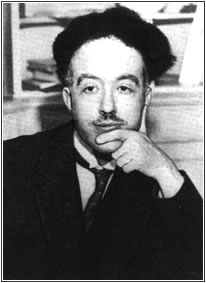
You are here: Home >> History of Light >> Quantum Mechanics >> ...L. de Brogle
 Louis de Broglie used to be enlightened scientist. Although his parents wanted him to become in diplomatic service (after his degree in history), he refused a famous career to follow his dream. He was deeply affected from Planck and Einstein and in the end he became an equal scientist to them.
Louis de Broglie used to be enlightened scientist. Although his parents wanted him to become in diplomatic service (after his degree in history), he refused a famous career to follow his dream. He was deeply affected from Planck and Einstein and in the end he became an equal scientist to them.
In 1923 he suggested that all particles -not just photons- have both wave and particle properties. He calculated that every particle has a wavelength (represented by λ, the Greek letter lambda) equal to Planck's constant (h) divided by the momentum (p) of the particle.
Electrons, atoms, and all other particles have de Broglie wavelengths. The momentum of an object depends on its speed and mass, so the faster and heavier an object is, the larger its momentum (p) will be. The de Broglie wavelengths of everyday objects are so tiny that the wave nature of these objects does not affect their visible behavior, so their wave-particle duality is undetectable to us. For this theory he was awarded the 1929 Nobel Prize in physics.
These proposals were nothing but a revolution in science. In 1927 Clinton Davisson and Lester Germer of the United States confirmed Broglie's hypothesis for electrons. Using a crystal of nickel, they diffracted a beam of monoenergetic electrons and showed that the wavelength of the waves is related to the momentum of the electrons by the Broglie equation. Since Davisson and Germer's investigation, similar experiments have been performed with atoms, molecules, neutrons, protons, and many other particles. All behave like waves with the same wavelength-momentum relationship.
de Broglie's scientific evolution